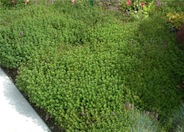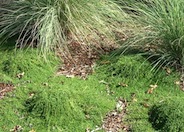
Common name:Thyme, Creeping 'Purple Carpet'
Botanical name:Thymus praecox arcticus 'Purple Carpet'
This perennial will grow about 3" tall and 3' wide. It has small, dark green leaves with clusters of purple lavender flowers that bloom in spring and summer. Leaves are fragrant when crushed. Butterflies love this plant too. This ground cover looks great between pavers, as a lawn substitute withstanding some foot traffic.

Common name:Thyme, Creeping 'Elfin'
Botanical name:Thymus praecox arcticus 'Elfin'
This 2" perennial groundcover is a great addition among other sun-loving perennials. Its creeping stems bear small purple flowers all summer. The plant spreads quickly, and should be placed in average to moist garden soil. The scented foliage can be used to flavor food. -Holland WIldflower Farm

Common name:Thyme, Creeping / Mother-of-Thyme
Botanical name:Thymus praecox arcticus
This evergreen groundcover needs full sun to light shade. It grows to 3" tall, forming a dense, thick mat. It needs well-drained, light soil. Creeping Thyme is considered drought tolerant. The foliage is dark green and slightly hairy. It has a pleasant, minty fragrance when crushed, though not considered for culinary uses. Flowers are lilac purple and bloom in the summer. It attracts bees and butterflies.

Common name:Rosemary
Botanical name:Rosmarinus officinalis
Rosemary is hardy in full sun areas where winter temperatures do not drop below 10 degrees F. Rosemary is evergreen and makes a great aromatic hedge, 4'-6' tall and 2' wide. Foliage is used in cooking. Blue flowers appear in summer. This plant is drought tolerant once it's established. Bees love Rosemary!
If you have impermeable paving that you would like to make permeable, there are two main methods for doing so:
1. Break up hard paved surfaces to create spaces for water to seep through.
2. Remove and replace the surfaces with permeable paving.
Click in the green box for more information
Designer: North Mountain Park
Photographer: Julie Smitherman
Maintain a two to four inch layer of mulch on the soil surface to reduce weeds, infiltrate rain water, and reduce compaction.
Be sure to fix all leaks promptly no matter how small they may seem.
Remove irrigation water and fertilizer from areas where you don't want weeds to grow.